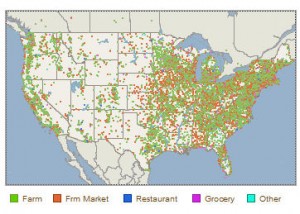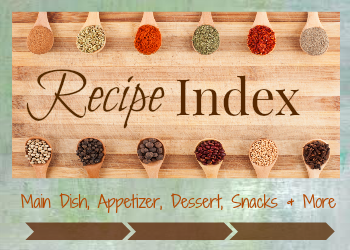
I talk a lot about my vegetable garden and I know that some of you don’t have the time and space to have your own garden. Today my friend Ann from Coupons, Deals and More wrote a guest post for you on CSA’s. As you can see from the map above, there is a high concentration of CSA’s on the East Coast.
Community Supported Agriculture, or a CSA, is a great way to save money on produce. You purchase a half or full share, and depending on your local produce season, receive a bag or box of produce every, or every other, week.
Residents of areas with year round growing climates could receive up to 52 weeks of produce. Those of us up north typically receive 22-26 weeks of produce. The seasonal price will be adjusted to align with your growing season. For instance our share is $300 and we will receive approximately 24 weeks of produce- give or take two weeks – depending upon the length of the growing season that year. Year round CSAs may be more than double that price.
Each CSA has different rules on distribution; some are strictly farm pick-up and some deliver to your front-door. My local CSA members take turns driving to the farm (usually once per season) and we will pick-up the produce bags for everyone in our group. These are dropped off at the centrally located pick-up destination set-up by the CSA in advance. CSA members will receive their weekly bags from this house/store/church.
If we cannot pick-up our bag (or have someone pick-up our bag for us), we notify the CSA by Thursday and they will donate our weekly share to the local food pantry. I am sure different CSAs have alternatives to the food pantry.
There are drawbacks to a CSA, the biggest one being that you get what is in harvest, and that can be copious quantities of one specific type of fruit or vegetable. Sometimes we have so much lettuce in the house I feel like a rabbit! With freezable, can-able or hydratable produce, the abundance can be used year round. We usually receive enough produce in our 24-26 weeks to have “fresh” vegetables all year- round. Because we are in the northeast our produce is more abundant from August – November. As
the season wears on we receive greater and greater amounts of produce in our weekly bag as the CSA distributes what it harvests. By October our bags are pretty darned heavy.
You also need to check that your local CSA will not require you to work on the farm at any point (unless you are into that). If you are unsure whether a CSA is for you, many CSAs will give you a one-time free bag to try just for the asking.
Foodnews.org has a download guide that separates the good organic buys from the unnecessary ones.
There are many types of CSAs – vegetable, fruit, cheese, eggs, honey the list goes on and on! The most common types of CSAs are organic produce, so definitely look into this if inexpensive organic produce is important to you.
Ann owns and writes Coupons, Deals and More – a blog dedicated to helping you save money. With over 25 years of couponing experience, Ann has been at the saving game a long, long time.
Latest posts by Renae Chiovaro (see all)
- Last Minute Batgirl Costume - October 22, 2016
- Agnes & Dora: Comfortable & Affordable Clothing - September 19, 2016
- Life is a Highway - September 17, 2016







[…] For more information on what a CSA is, checkout my previous post on What is a CSA?. […]